 Photo from Unsplash, taken by Jorge Fernandez Salas Photo from Unsplash, taken by Jorge Fernandez Salas I feel like I need to start this post by saying: I'm not telling you not to play gladiator board games. I play them. I enjoy them. I have no intention of stopping. But I think it's important to reflect on the differences between what we know about history and what we are presenting in our board games. That said, did you know that most ancient gladiators were slaves? Over the last several years, board gamers, both in and out of academy, have taken notice of colonial themes in board games. Strategy games such as Puerto Rico, Struggle of Empires, and Archipelago have entered not only the Top 100 games on BoardGameGeek, but have received treatment from scholars of postcolonial studies because of their focus on colonial economies and the in-game presence of slaves (1). On the consumer end of the spectrum, games have either drawn criticism or been withdrawn from publication due to insensitive colonial theming. Notably, a recent GMT project entitled Scramble for Africa, described in a press release as a “game of the period of exploration, colonization, and exploitation of Africa from around 1850 to 1900,” (2) was going to be published, but was ultimately withdrawn from the production line due to outcry over the game’s Euro-centric enthusiasm for carving up the continent of Africa, with no regard for the painful consequences that still linger from when it actually happened (3). Meanwhile, historical gaming in particular is seeing a push towards telling a wider variety of stories from differing (i.e. not colonial or Western-centric) viewpoints (4). Overall, there is a movement within board games to show more sensitivity with regard to the subject matter of games and to the treatment of oppressed or previously silenced people who are portrayed in them. The subject of slavery has received especially close scrutiny, and with good reason. For every game that confronts the issue as a painful and upsetting historical episode (5), there are several more that contain references to slavery that trivialize—even incentivize—the mistreatment of enslaved people. Five Tribes, a game set in a fictionalized Middle East, had, and ultimately removed, a slavery-themed market card (6). More recently, Maracaibo, a strategy game based on 17th-century trade in the Caribbean, has drawn criticism for a card that allows players to profit from slavery within the context of the game (7). I see all of this discussion as a sign of progress. It's important to reflect on what games ask us to do, and the context of those actions both in actual history and in our current culture. But so far, discussion centers almost entirely on the more recent past. We have yet to seriously apply these new lenses to other historical contexts, to cultures that do not—at least as far as we can perceive—have as strong an impact on our own. While now a game in which slavery is practiced rightly incites discussion among gamers, these scruples do not currently apply to games set in the Roman world, and in particular to games about gladiators. So what are we doing with our gladiator games? What does that say about us? What does it say about our attitudes toward Roman culture? I'll be exploring these questions and more over the next several posts! Click here for the next part. References: (1) Borit, C, et al, 2018 Representations of Colonialism in Three Popular, Modern Board Games: Puerto Rico, Struggle of Empires, and Archipelago. Open Library of Humanities, 4(1): 17, pp. 1–40, DOI: https:// doi.org/10.16995/olh.211 (2) The original release has since been deleted, but remains in part on Twitter. GMT Games (@gmtgames), Twitter Post. Feb. 19, 2020, 6:00 PM, https://twitter.com/gmtgames/status/1098356792143138816?lang=en (3) Kevin Draper, “Should Board Gamers Play the Roles of Rapists, Slavers, and Nazis?” The New York Times, accessed Aug. 01, 2019, https://www.nytimes.com/2019/08/01/style/board-games-cancel-culture.html (4) “Zenobia Award,” accessed May 24, 2021, https://zenobiaaward.org/ (5) Dan Thurot, "The Compromises of This Guilty Land," Space-Biff! December 20, 2018, accessed May 24, 2021, https://spacebiff.com/2018/12/18/this-guilty-land/ (6) Michael Heron, “Five Tribes (2014) -- Accessibility Teardown,” Meeple Like Us September 30, 2017, accessed May 24, 2021, https://www.meeplelikeus.co.uk/five-tribes-2014-accessibility-teardown/ (7) Mandi Hutchinson (@bgpinup), Twitter Post, March 07, 2020, 2:37 AM, https://twitter.com/boardgamerpinup/status/1236194208970616832?lang=en
2 Comments
I haven't updated this website in a while. It's not that I don't like board games anymore, or that I don't enjoy covering them, because I very much do. It's more that I have been feeling creatively "stuck." I prefer to make review videos rather than write game reviews. I like to make tutorials, but trying to do them on a very strict schedule burns me out. And when I push myself too hard to do things anyway, I burn all the way out. I did not want to do that.
The thing I love to make the most, it turns out, is my podcast. Season 3 kicked off today, close to the one-year anniversary of my first episode. And I am still absolutely loving it. Which made me think--what is it, exactly, that I love about my podcast? Getting to know really cool, smart people is definitely part of it. But it's also that I'm finally having the kinds of conversations about board games that I find the most satisfying. I love discussing the history behind games, the intentions that designers have when creating them, the impact they can have on players. While I don't intend to stop making review and tutorial videos, I do want to lean in to what is truly making me happy. I think it's normal to evolve when you create things, and I'm going to go along with this process. So watch this space for different kinds of writing projects that I have wanted to do for a while. Expect a lot of thoughts about how games represent ancient history, what our games say about us, and other topics that get my gears turning. Hopefully, you'll think and explore along with me! Hey everyone!
This is just a quick update to let y'all know that I'm back from a break and both my videos and blog posts are about to resume. Expect more stuff soon—including a new BookTube channel, called Beyond Solitaire Books. See you soon! Liz 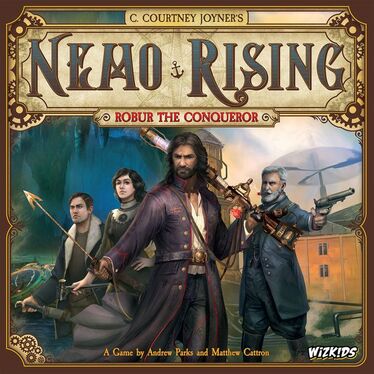 Full disclosure: I received a review copy of Nemo Rising from Wizkids. What is this game about? Nemo Rising: Robur the Conqueror is an adventure game based on the novels by C. Courtney Joyner. In it, you can play as Nemo, Sara Duncan, Adam Fulmer, and even Ulysses S. Grant as you go on steampunky adventures in which you secure locations you have explored, battle enemies who try to stop you, and complete missions. At the start of the game, you will have a specific number of "mission points," which are like the timer for your game—if you run out before you meet your goals, it's game over. But you'll also be tempted to spend those points to choose better action cards at the start of your turn, and you'll sometimes have to pay them as the penalty for failing skill checks or being overwhelmed by enemies. Each turn, your character will have a set number of actions that they can use to move, explore, perform skill checks, and complete other tasks. The success of most actions is determined by the roll of a skill die, and there are different types of skill checks you'll need to pass. This is where action cards you select at the beginning of your turn come in—they can give you extra die rolls, or even guaranteed successes of a particular type. Nemo Rising comes with two different adventures. One takes place underwater, while the other takes place in the air. They have custom enemies, art, and cards to provide slightly different experiences, and it's clear this game has been built to be expandable. How does it play solo? Nemo Rising has a variant that allows you to play with a single hero, but I recommend playing two-handed and choosing two characters. 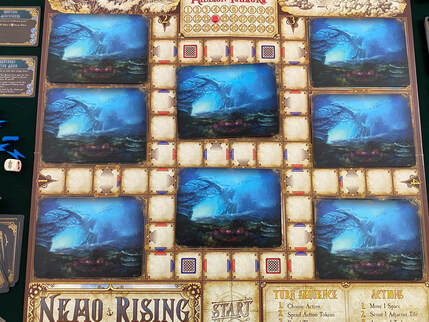 Undersea locations waiting to be discovered. Undersea locations waiting to be discovered. Overall Thoughts Nemo Rising is a nice production with lovely art and a very comprehensible rulebook. I especially think that Nemo Rising might be a good choice for relatively new hobby gamers who want to take things to the next level, but aren't sure where to start. The game is cooperative and fairly simple to learn, but also offers some good player choices. It's also easily expandable, so groups who love this game can probably expect to see more of it. However, Nemo Rising suffers from a common problem with board games right now—it's not a bad game, and there's nothing actually wrong with it at all. But does "there's nothing wrong with it" actually mean "it's good"? While the gameplay is solid, it also lacks a certain level of excitement. After a few plays, games of Nemo Rising seem to run together and feel the same, even if you're switching between the air and water adventures. The game's simplicity, which might make it a very good gateway for some groups, also hobbles it when you start to want more choice, as well as more tension. It's usually clear what you should do, and it's just a matter of whether you can get the die rolls to make it happen. Do I recommend it? Maybe? I actually like Nemo Rising well enough. It isn't a bad game, it's beginner friendly, and it looks beautiful. But you could also spend your money on something that makes your heart sing. Overall Rating: 3 stars Rating Scale: 5 stars — I love it! 4 stars — I really like it. 3 stars — I like it. 2 stars — It's okay. 1 star — Meh. 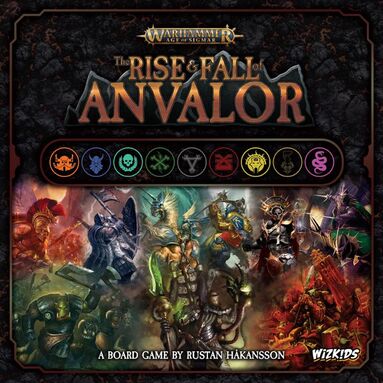 Full disclosure: I received a review copy of The Rise and Fall of Anvalor from Wizkids. What is this game about? Warhammer: Age of Sigmar - The Rise and Fall of Anvalor is a tower defense game set in the Warhammer universe. In the game, you'll be playing one of six factions that comes with a unique deck of tiles. Your task is to build up the city of Anvalor and gain as much influence as possible while doing so. On each turn, you'll use the resources on some of the tiles in your hand as payment to place other tiles. Some of the tiles you place will be buildings, while others are units. The configurations in which you place your tiles will provide various bonuses that you'll need to take on enemies—and you will definitely need to battle it out with some enemies. While most of the buildings you place will be from your own faction, you'll also want to place city buildings that represent contributions to Anvalor. And once you do that, you'll draw the attention of marauders outside the city gates. In addition to offering several player factions, The Rise and Fall of Anvalor also offers three different enemies to choose from, each of whom is customizable because you can set the difficulty level. Once city buildings are placed (or just automatically in the solo game), you will roll for enemy actions. Most of the time, enemy tiles are placed facedown on the outskirts of the city. On a roll of 5 or 6, a special (and not fun) effect may occur. When enough enemies have built up on one side of Anvalor, their presence will trigger an assault, and enemies will pass through your city, destroying everything in their wake, until they either die or pass all the way through Anvalor to disappear on the horizon. In the multiplayer game, the goal is to survive all of the enemy assaults with more influence than any of the other players. In a solo game, you'll need to finish the game with at least one city building still standing after all of the enemy tiles are gone. How does it play solo? The Rise and Fall of Anvalor comes with a solo-specific mode. In solo, you will play as one faction and will have slightly different victory conditions. In a solo game, you roll the enemy die every turn, even if you have not constructed a city building yet. You will also need to have at least one city building still standing at the end of the game in order to win. If you are victorious, your influence will become your score. 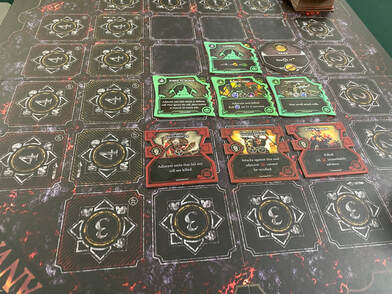 Overall Thoughts Warhammer: Age of Sigmar - The Rise and Fall of Anvalor is ultimately a fun game. It's a very heavy box filled with relatively light and snappy gameplay. There are a lot of interesting choices to make, including picking a faction and special ability, as well as an enemy with an adjustable level. It is also enjoyable to get to know your faction deck and figure out how to make smarter plays that maximize the synergy among tiles in your player deck. I also tend to like games where you "purchase" cards to play by discarding other cards from your hand, and I still like that mechanism in Rise and Fall of Anvalor. Having to choose what to keep and what to sacrifice adds another layer of fun to the in-game choices already on offer. That said, Rise and Fall of Anvalor isn't perfect. For all of your carefully laid plans, your success is still going to come down to a die roll, which will inevitably be frustrating at times. The game can seem swingier when your enemy faction is set at a high level, because the powers they have when you roll high on the enemy placement turn are a lot nastier compared with lower-level powers. I also think that enemy interactions in this game could have been a bit more interesting. Enemy tiles are placed facedown on the board and not revealed until it's time for an assault, which can hobble your placement strategy. I would have liked to try to respond to shifting enemy presence throughout the game in a way that I can't when the enemies are facedown. Also, while enemy assaults as currently designed probably do make the game snappier and more pleasant to run, I am always a little disappointed when enemies that aren't killed just run out of the other side of Anvalor, never to be seen again. Some deeper interaction might have added interest to the game. Do I recommend it? Possibly. This game doesn't knock my socks off, but it's good fun, and I think I might have liked it even better if I had a deeper appreciation of its Warhammer theme. Overall Rating: 3.5 stars Rating Scale: 5 stars - I love it! 4 stars - I really like it. 3 stars - I like it. 2 stars - It's okay. 1 star - Meh. 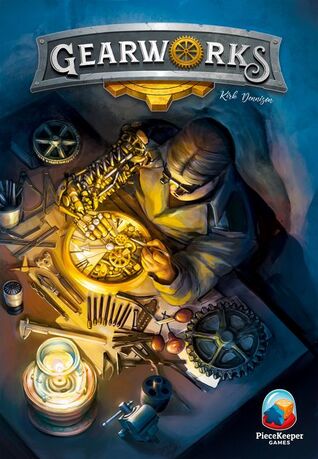 Full disclosure: I received a review copy of Gearworks from Piecekeeper games. What is this game about? Gearworks is a light, fast card placement game in which you are tinkerers scrambling to get the parts you need to build steampunky contraptions. Ultimately, the player who builds the best contraptions will earn the most points and the win. At the beginning of each round, players will receive secret contraption cards that help them decide which machine parts to go for. If they can end the round with one or both of the parts displayed on the card, they can build the contraption and earn victory points. To stake a claim to parts they need, players will need to carefully deploy the gear cards in their hands. The play area for a game of Gearworks consists of a grid where you can place cards in rows and columns, following particular placement rules. Being the player who most recently played a card to a given row and column gives you dominance over those parts of the grid, and the possibility of winning the parts associated with that row and column at the end of the round. In addition to playing cards and vying for parts, players can earn and spend special tokens called Sparks. Sparks allow players to reenter the game after they have passed, to play a card in their hand on top of a card already placed in the grid, to draw extra contraption cards, and to otherwise manipulate the game to their advantage. While all players automatically receive starting sparks, you can also gain them by discarding gear cards or by "tinkering," which means placing a card on the grid in a space where it equals either the sum of or difference between cards with which it shares a row or a column. How does it play solo? Gearworks comes with an automated solo opponent called The Leviathan that plays according to automated rules. Rather than respond to what the player is doing, the Leviathan will act based on cards drawn from the contraption and gear decks. Based on the locations and values The Leviathan draws, it will attempt to make a legal placement somewhere in the grid. 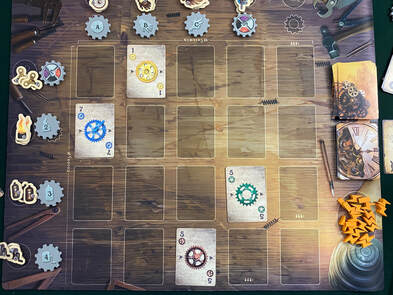 Playmat not included, but it really does help. Playmat not included, but it really does help. Overall Thoughts Gearworks is a quick and clever game that I really appreciated. There are a lot of fun, strategic things to do with the cards in your hand, and you'l find yourself constantly checking the board state. Constantly vying for dominance over specific rows and columns is both exhilarating and frustrating, and there are a lot of opportunities to fake your opponents out if you are willing to conceal what you want or even pass and then pay sparks to reenter the round at the last minute. You also have the option of coming on strong right from the beginning of a round and fighting aggressively for the parts you want. However, my positive feelings about Gearworks come with an enormous caveat. Multiplayer Gearworks is slick and fun. Solo Gearworks, however, is clunky and disappointing. The Leviathan works, but it is not only extremely annoying to run (PieceKeeper provided a flowchart on BGG that is mind-bogglingly complex for such an ostensibly simple game and bot), but also can't give you the excitement of strategically scrapping for control of a row or column, or the quiet pleasure of faking out your friends. I know it feels like the right thing to provide a solo mode for as many games as possible these days, but in the case of Gearworks, the solo mode loses too much of what makes the game fun with other people. Do I recommend it? For multiplayer, yes. Gearworks is inexpensive, fun, and a game I'd like to try with my students. For solo? Do not recommend. Overall Rating: 3 stars Overall Rating: 5 stars - I love it! 4 stars - I really like it. 3 stars - I like it. 2 stars - It's okay. 1 star - Meh. 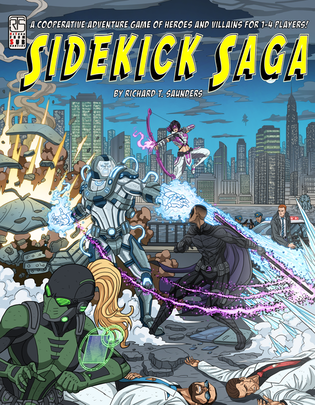 Full Disclosure: I received a review copy of Sidekick Saga from its designer and publisher, Richard T. Saunders. What is this game about? Sidekick Saga is a superhero-themed game in which the heroes have all disappeared—and you are the sidekicks they've left behind. You'll be working to find your missing mentors, while also trying to keep criminals in the city at bay. The goal of any game of Sidekick Saga is to take out the main bad guy of the scenario. But to do that, you'll need to work your way up through the less potent enemies who are protecting their boss. Each scenario offers a different configuration of enemies to deal with, and you'll all be battling each other at various locations across the city. During the game, you deal with a "bad news" card that helps time your game, then move from location to location, choose whether to spend your turn as a hero or as your "regular" self, combat enemies, use hacking to take bad guys out of commission, collect leads, and draw cards from the location decks to acquire useful abilities and tools. The game is a "green legacy" that introduces new rules, keywords, and characters over the course of multiple scenarios, but if you wanted to, you could reset and play the story again. Sidekick Saga also comes with a skirmish mode that offers challenges outside of the main storyline. How does it play solo? Sidekick Saga is a cooperative game, so it's a simple matter to solo it by playing two-handed and running two sidekicks. 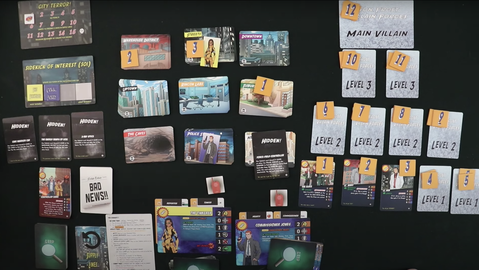 Overall Thoughts Sidekick Saga is a functional game, but I wasn't feeling it. There are several things that it does well. One of these is the introduction of new mechanisms over time—the scenario books are printed as comic book "issues" that reveal a bit more story and a few new tricks each game. The power upgrades and access to new characters are well timed, and the inclusion of a skirmish mode outside of the storyline is thoughtful. I also like that hacking is an element of combat to help you trip up enemies you can't outright defeat—it allows you to spend your turn taking them out of commission, but it's only temporary, and it keeps you from going after more immediate threats. That said, Sidekick Saga is a personal dream, not a polished product from a major publisher—and you can tell. I feel bad saying it, because what is Kickstarter if not a place for people to turn dreams into realities? But the rulebook needs an editor, the graphic design is chaotic and sometimes sloppy (there can be 3 different fonts on a single card), and there are aspects of the game that could have been smoothed out with more playtesting. The gameplay works well enough, but it isn't as zippy and fun as I would want from a game with this theme—typically a turn is spent digging through location decks, and not feeling like a burgeoning superhero at all. There are also aspects of the game, such as the "Suspect of Interest," which represents how much enemy attention you're drawing, that you are required to pay attention to, but that make you work more than they add to the drama of the game. And in a market that is full of very strong superhero games, it's not possible for even a pretty good game to get traction. Sentinels of the Multiverse and Marvel Champions are both absolutely fantastic games. I enjoy Marvel Legendary, there is a DC deckbuilding game that I hear is decent, and I am very excited to see what the Sadlers have done with their upcoming superhero game, Hour of Need. (The art alone for that one is stunning so far.) In a world where gamers are spoiled for choice, a game that works isn't quite enough anymore. Do I recommend it? No, not unless you are absolutely jonesing for another superhero game. However, elements of this design show promise and I would be willing to try the next game published by this designer. Overall rating: 2.5 stars Rating Scale: 5 stars - I love it! 4 stars - I really like it. 3 stars - I like it. 2 stars - It's okay. 1 star - Meh. 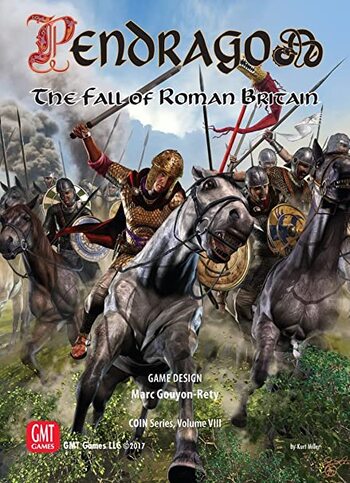 What is this game about? Pendragon: The Fall of Roman Britain is a COIN game set during the 4th and 5th centuries A.D., when the Romans still occupied Britain, but their power there was starting to wane. In the game, four factions each pursue different goals—the Dux, or Roman military, wants to maintain control over Britain, as well as increase Roman prestige in the area. The Civitates are their frenemies—Roman-British civilians who are also interested in stability and control, but who want to wrest power from the grabby Dux faction. Early in the game, the Dux can spend the Civitates' money, while the Civitates benefit from the support of Dux military forces. But both factions are careening towards fragmentation, when they split from each other and change the face of the game. Their common enemies are two factions of barbarian raiders—the Scotti from the west, who are looking for a tidy profit, and the Saxons from the east, who are initially only in it for the money but who develop an interest in a more permanent settlement post-fragmentation. Because Pendragon is a COIN game, the action always starts with an event card—one event card is active per round, and each faction in the game has a chance to act in the order printed on the card. But there's a catch: Only two factions get to take a turn per event card. Factions also cannot act two rounds in a row, which means that players will need to make important decisions about tempo. Everyone is able to see both the current event card and the upcoming one, and sometimes it is in a player's best interests to pass during one round, giving up a chance to take a turn because they want a crack at the event card that's currently on deck. Once a player decides to take a turn, there are even more interesting choices involved. If you choose to take the event printed on the card, then the second player for the round gets to take a full action. If you take a full action, the second player for the round might get to play the event card themselves. But if you take a limited action, you also limit what the second player for the round can do—by hobbling yourself, you also put a damper on your opponent. Your faction also has its own set of actions to take. You might want to move units, build, or fight, and all of these will cost you precious resources. The result of all this is a big, messy conflict that mirrors all the interesting parts of the decline of Rome's power in Britain. Every so often, an Epoch card will emerge from the event deck, which triggers a special round during which players check for victory conditions. If any faction is meeting its victory conditions during an Epoch round, then the player of that faction wins. Otherwise, play continues. If no clear winner emerges by the final Epoch round, then players tally points based on their individual faction goals to determine the winner. How does it play solo? Pendragon comes with a bot for each faction, so you can play one faction yourself and use bots for the other three. These bots are flowcharts that ask you to check the board state and then make the most logical choice for the faction that is taking a turn. In Pendragon, I think it's best to start by controlling both the Dux and Civitates factions before fragmentation, then take over whichever faction is weakest after fragmentation (this encourages you to give equal love and attention to each faction during the early part of the game). The Scotti and Saxons have simpler bots to run, which will make your first solo games go more smoothly. 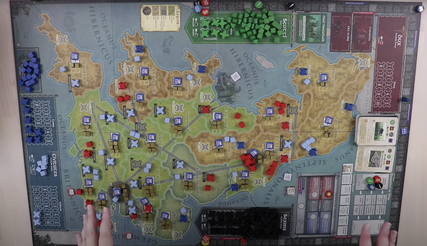 The board is so big I usually leave it sideways. The board is so big I usually leave it sideways. Overall Thoughts As a simulation of Roman history, Pendragon is fantastic. From the fascinating designer notes and bibliography to the actual gameplay, where tensions between factions play out in ways that mirror historical events, this game is steeped in its setting. It's obvious that Morgane Gouyon-Rety knows her stuff. And when you play her game, you'll come out knowing a bit more, too. As a game, Pendragon is full of delightful choices. How closely should the Dux and Civitates work together, knowing full well that a split is on the horizon? When is the right moment for invading barbarians to try to settle down in the land they've pillaged? When is the event on a card really worth taking, as opposed to taking a normal action? And is it safe to go for it and take a big turn, knowing full well that another faction might take advantage and do something irritating to hurt you? Resources are precious, which means that every decision, from splurging to pay for road maintenance to engaging in battle, can have serious consequences. This game does not reward careless decision making, and even the best laid plans can be torn apart by some bad die rolls during conflict. Pendragon also represents an interesting development of the COIN system. COIN (COunterINsurgency) games typically focus on specific conflicts between powerful governments and insurgents within a limited period of time. Pendragon covers centuries, and to fit its theme, it dispenses with common elements in other COIN games, such as guerilla fighters. I liked most of the tweaks made to the system, and I think the design decisions were well made for Pendragon's setting. That said, Pendragon is a heavy game within an already-heavy system. It is the most complex COIN game I have played, and while every aspect of the game makes sense and is explained in the rulebook, there is a lot going on, especially when moving through all the stages of a battle. It is not a casual game for a lazy afternoon--Pendragon is a rewarding but very consuming experience, even if you choose to play only a short game. (There are several scenarios of varying lengths.) I adore playing this game, but I also know that it won't make it to my table as often as I would like. I also think that it is easier to play some factions than others. When soloing as the Scotti, it seems easier to roll over the Dux and Civitates than it does to play as the Romans who are trying to squash those pesky barbarians. I intend to keep testing this theory over time. Do I recommend it? If you want a deep game that is both excellent to play and excellent as a historical simulation, then Pendragon is a great choice. But be ready to invest a lot of time and effort into learning it, particularly if you do not have experience with COIN games. (I personally would recommend starting with a different game in the series, but perhaps you wish to live dangerously.) Overall Rating: 4 stars Rating Scale: 5 stars - I love it! 4 stars - I really like it. 3 stars - I like it. 2 stars - It's okay. 1 star - Meh. 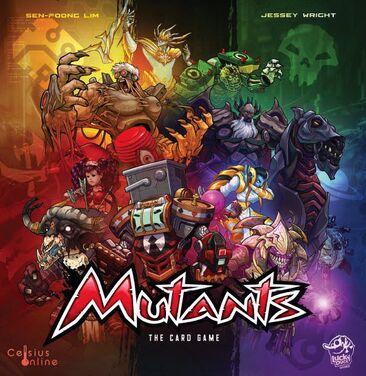 Full disclosure: Lucky Duck Games provided me with a review copy of Mutants. What is this game about? Mutants is a tactical card-battling game in which each player has a team of mutants ready to fight it out in the arena. The main point of the game is to score the most victory points before the end of five rounds. This feat is primarily achieved by performing well on the dominance track. In Mutants, there is a constant battle for "king of the hill," as players gain power and try to force their enemies to lose it. If one player can get into the "fury" space on the dominance track, while forcing opponents into the "dread" space, then they have a chance at more victory points every single turn. As players cycle through their decks, they also thin those decks by "freezing" mutants. Frozen mutants are removed from play, but they are also worth victory points at the end of the game. All players start with the same set of basic mutants, but can access more powerful mutants based on either a draft or on deck construction that takes place before the actual battle. On each turn, players have a choice between three actions. They can deploy a mutant, which means putting it into their active mutant space and using its activation power. They can breed a mutant, which means discarding two cards with genes that match an advanced mutant, and then bringing that more powerful card immediately into play. Or they can discard only one card to "incubate" an advanced mutant, which allows them to put it on top of their deck next round (but they have a no-action turn during the current one). There are also some fun spatial elements to gameplay that take place on the player board. Mutants start out in the "active mutant" slot, but players must slide the previous active mutant to the left or to the right each turn. Mutants are eventually slid off of the player board altogether, which can activate further special powers. Most mutants have a power that is triggered when they become active mutant, and if they can leave the board without being knocked down, they have a second power that is triggered when they leave the board. How does it play solo? Mutants comes with several solo bosses who have their own decks and special powers. The base game includes two solo bosses, with three more available across the expansions. While in the multiplayer game everyone is vying for victory points, in solo, you use the same mechanisms to reduce the boss's life total instead. When the boss is kicking your butt on the dominance track, you aren't punished, but they can gain life back and undo all of your hard work. If you can get the boss down to zero life in five rounds, you win! 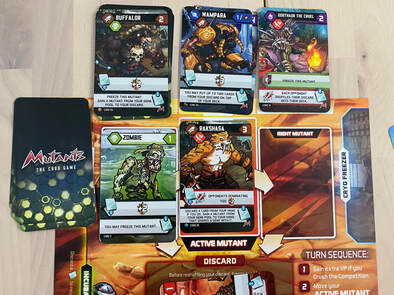 The board with mutant slots and advanced mutants to choose from. The board with mutant slots and advanced mutants to choose from. Overall Thoughts Mutants was a very pleasant surprise for me. I hadn't even heard of the game until Razoupaf told me about it, and wasn't sure what to expect. What I got was a quick, snappy card battle with some very light deck construction. I particularly like the way the dominance track creates a constant struggle, with both you and the solo boss scrambling to get to the top and push each other down. Depending on what cards come out, you can go from top of the world to rock bottom, then have to find a way to scramble back up again. I also like that Mutants is fast but still full of decisions. What advanced mutants should be the core of the deck I construct? Can I afford to incubate, which will give me a better card later, but do nothing to hurt the boss this turn? What tactical plays can I make with my cards to keep the boss from slipping ahead of me on the dominance track? Which card should I freeze—a weaker one that is worth fewer points, or a more powerful one that will knock a few extra points off of the boss's life total? Even deciding whether to slide a card to the left or to the right can be an important choice, based on what cards are in play and which areas on your player board might be attacked. For all of these choices, Mutants is still a light card game. The cards you have access to during any given game are limited, and the powers are fun but not overwhelming. In some ways this is a little disappointing, because you aren't going to manage deep deck construction or deck building the way you might with a chunkier game. But if you want a fun skirmish that doesn't take all night, then Mutants may be a good choice. I will say that I'm not convinced that Mutants is a great pick for solo-only play. The two bosses in the base box are not enough, and one of them, Jack Ice, is so difficult to beat with cards from the base box that I haven't figured out how to do it yet. (If you have, let me know in the comments what advanced mutants you were using!) To get the fullest possible solo experience, you'll need to purchase both of the expansions in addition to the base game, for a total of five bosses. At list price, that will come out to about $90 total—a steep price for a solo game that is very fun, but not one for the ages. If you are planning to play Mutants both alone and with friends, though, I think you'll get your money's worth. Do I recommend it? Yes, if you plan to play both alone and with others. Mutants is mechanically excellent, but I'm not convinced it's a great value for solo. Overall Rating: 3.5 stars 5 stars — I love it! 4 stars — I really like it. 3 stars — I like it. 2 stars — It's okay. 1 star — Meh. 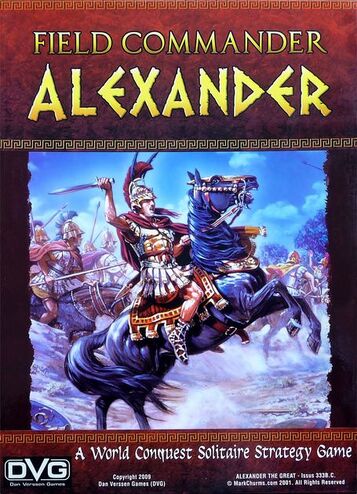 Full Disclosure: I received a review copy of Field Commander: Alexander from Dan Verssen Games What is this game about? Field Commander: Alexander is an entry-level war game in which you take on the role of Alexander the Great during some of his most famous battles. The game comes with four boards, one for Granicus, one for Issus, one for the Siege of Tyre, and one for Gaugamela. You can either choose one of these scenarios and play it, or you can link them all together as one big campaign in which you try to establish Alexander's prominent place in history. As you move Alexander's army, you'll have a lot of choices to make. Resources are incredibly tight, and you'll find that you never have enough gold—yet you are always tempted to spend more of it. A large army makes it easier to win battles, but can also make it more expensive to move. A small army makes it easier to take damage when making a scouting roll, and will of course make battles a bit more harrowing. Each time you conquer a pivotal area, you will choose whether to raze it for a large amount of gold now, or govern it for a smaller amount of gold during each remaining turn. And you can also spend your gold and glory to build temples, build cities, gain insights (special powers during the game), acquire advisors, and gain access to more and better battle plans. While in some situations you will have to battle opposing armies, there are also times when you have a choice between fighting and intimidation. You'll also have to choose whether to accept and fulfill prophecies. Prophecies can have annoying conditions when you just want to get on with it and win a campaign—but they are also the key to leveling Alexander up over the course of a game. He is fairly weak and can die easily early on, but over the course of his life, he becomes extremely powerful. This is particularly important in battle, because if Alexander can defeat the enemy leader, he ends the entire fight immediately. However, once he chooses to attack an enemy leader, they are locked in combat until the battle is over, which is a high-risk situation early on when Alexander isn't powered up yet. Your biggest choice may simply be when to end your turn. While your enemies only get one chance to carry out orders each round, you can complete your conquest turn as many times as you wish—it's up to you when to stop. If you push hard, you have a better chance to end with a higher score because you are rewarded for finishing faster. But the harder you push, the more beat up your army might get, and the less gold you'll have to keep funding your continued movements. At the end of the game, you'll determine how many victory points you've earned based on how long it took you to complete the scenario, and on how many cities you built. If you're playing a larger campaign, you're playing for immortality points, so you'll also want to make choices that benefit Alexander in the long run. How does it play solo? Field Commander: Alexander is a solitaire-only game. Yay! 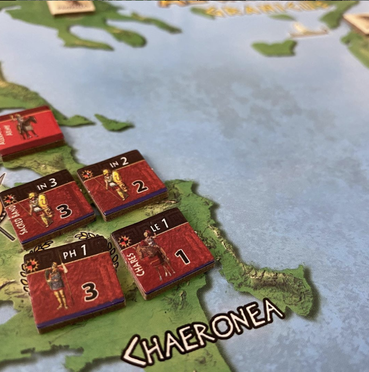 Overall Thoughts Field Commander: Alexander is a very enjoyable game, and one that is highly accessible to new wargamers. If you're looking to move chits around a map and have them get into a few fights, but you've never done it before, then I think this game is a great choice. Setup instructions for each scenario, as well as turn order and any other specific information you might need, is printed directly on the game board. Although there are many choices to make in Field Commander: Alexander, they mostly boil down to how much money you have. The game is very economically tight, and trying to make decisions for the long run when you have immediate needs gives the game a lot of interest, particularly when you are playing the long campaign, which rewards you more for your long term investments. Deciding how far to spend down and how hard to push yourself is the heart of the game, and it provides a lot of tension and drama. The bells and whistles are fun, too—selecting advisors and battle plans is great fun, and also makes battles something more than just die rolling. A well chosen and correctly executed battle plan can be tremendously satisfying. However, Field Commander: Alexander has its limits. For all of the fun choices it offers, the game is very linear. You'll do roughly the same things in the same order every time, which can make you feel like you've "solved" the game after you've played it enough. Although enemy orders and operations can be a pain, the enemies remain relatively static. The pressure to move quickly in the quest for maximum victory points also takes a little of the fun out of the game, because you don't pause and fully enjoy all of the game's options. Outside of the campaign, your highest scores are likely to be the ones you hit when you were pushing your army hard and getting lucky, not fretting over all of the smaller choices like building or picking up extra advisors or fulfilling prophecies. Things are a bit better when you are campaigning and going for "Immortality Points" instead of VP, but even then you will end up puzzling out the best course of action over time. Do I recommend it? If you are a new wargamer or very interested in Alexander the Great, then yes, you will have a good time with Field Commander: Alexander. I have enjoyed my time with it, but don't feel that it is a permanent "keeper" in my collection. Overall Rating: 3.5 stars Rating Scale: 5 stars — I love it! 4 stars — I really like it. 3 stars — I like it. 2 stars — It's okay. 1 star — Meh. |
AuthorMy name is Liz Davidson, and I play solo board games. A lot of solo board games... Archives
August 2021
Categories
All
|
 RSS Feed
RSS Feed